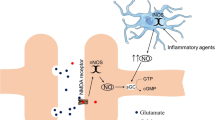Abstract.
Glutamate excitotoxicity, oxidative stress, and mitochondrial dysfunctions are common features leading to neuronal death in cerebral ischemia, traumatic brain injury, Parkinson's disease, Huntington's disease, Alzheimer's disease and amyotrophic lateral sclerosis. Nitric oxide (NO) alone or in cooperation with superoxide anion and peroxynitrite is emerging as a predominant effector of neurodegeneration The use of NO synthase (NOS) inhibitors and mutant mice lacking each NOS isoform have provided evidence for the injurious effects of NO derived from neuronal or inducible isoforms. New neuroprotective strategies have been proposed with selective NOS inhibitors for the neuronal (ARL17477) or the inducible (1400W) isoforms or with compounds combining in one molecule selective nNOS inhibition and antioxidant properties (BN 80933), in experimental ischemia-induced acute neuronal damage. The efficacy of these new strategies is well established in acute neuronal injury but remains to be determined in more chronic neurological diseases.
Similar content being viewed by others
Author information
Authors and Affiliations
Rights and permissions
About this article
Cite this article
Chabrier, PE., Demerlé-Pallardy, C. & Auguet, M. Nitric oxide synthases: targets for therapeutic strategies in neurological diseases. CMLS, Cell. Mol. Life Sci. 55, 1029–1035 (1999). https://doi.org/10.1007/s000180050353
Issue Date:
DOI: https://doi.org/10.1007/s000180050353




